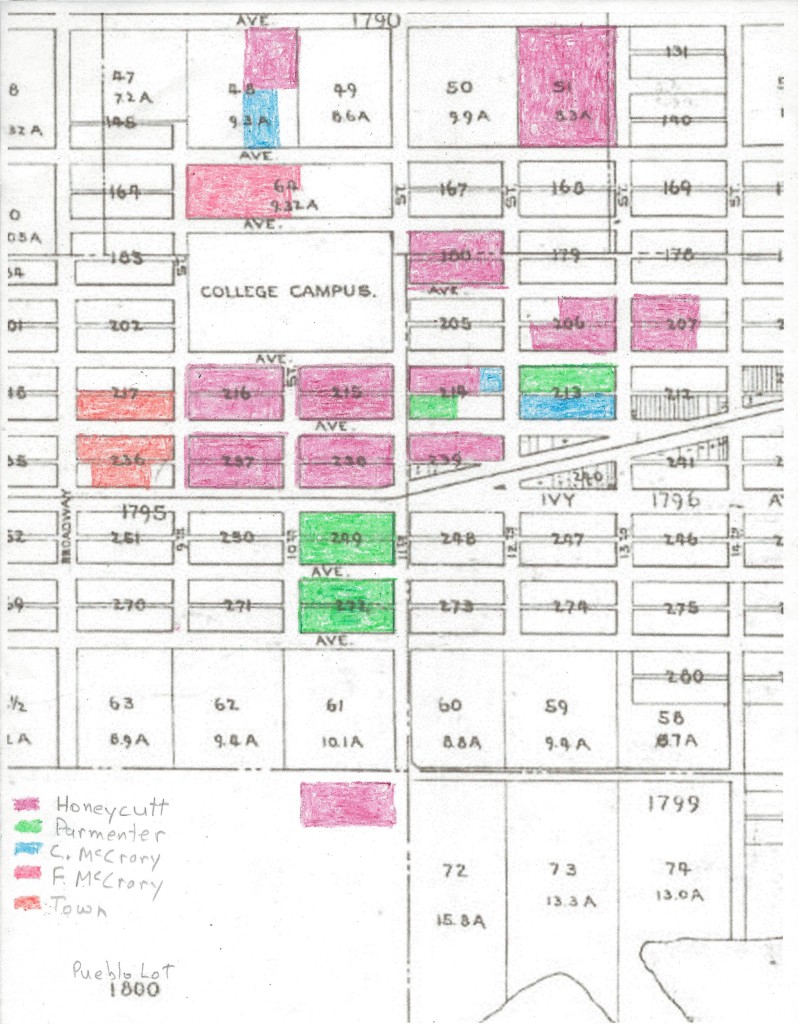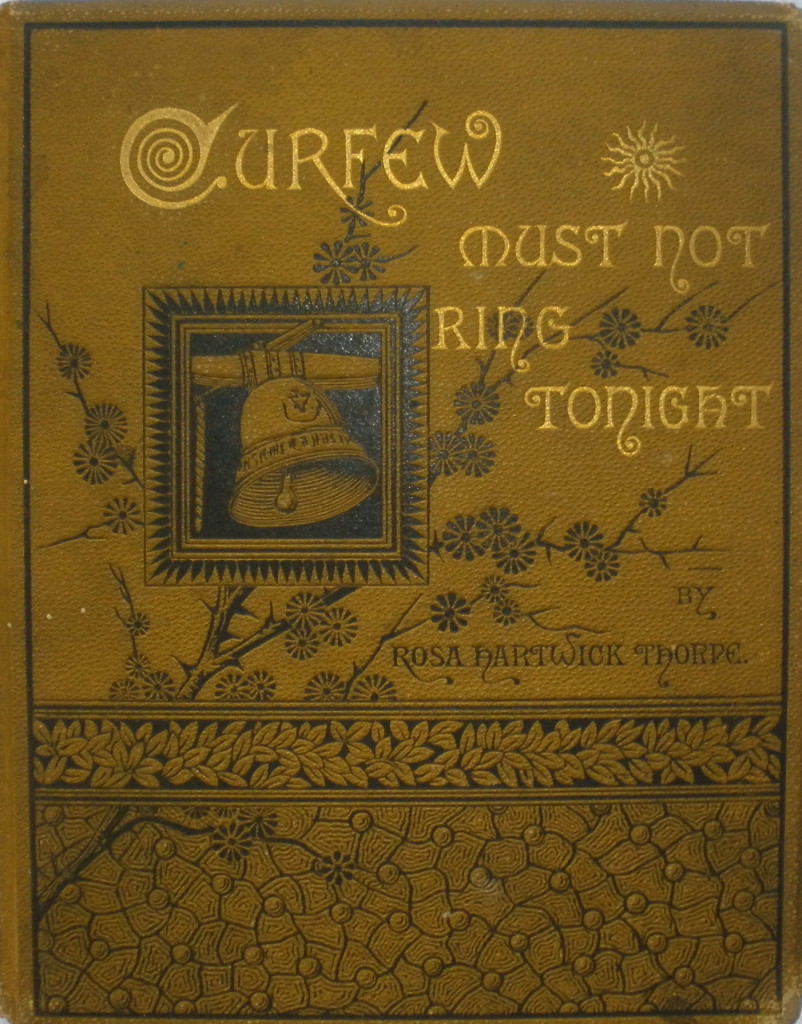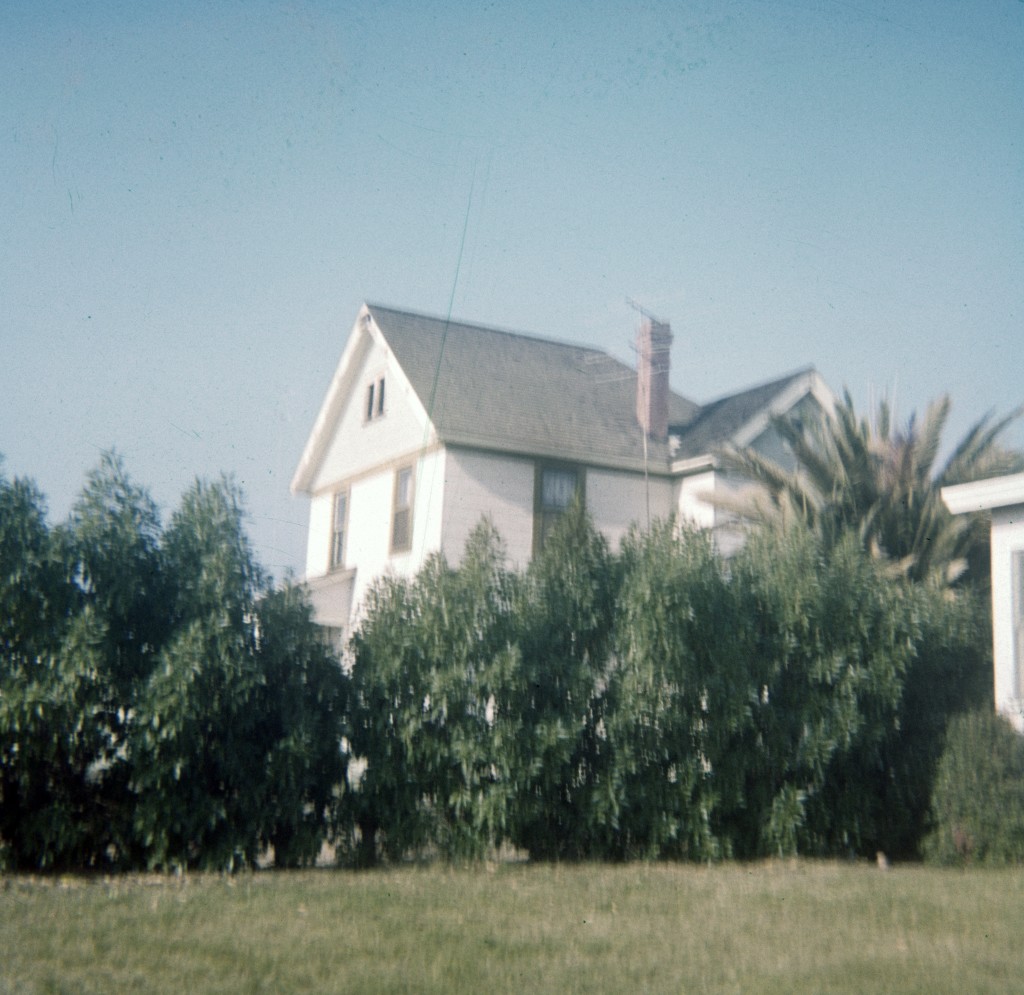Sterling Honeycutt was born in Tennessee in 1832. His family later moved to Indiana and in 1856 he married Nancy Huntington, an Indiana native. The couple moved to Rock Island County, Illinois, where in 1869 they reportedly erected the first residence in the village of Reynolds. They were also involved in building the first Methodist church in that area. In the 1880 census, Sterling Honeycutt, not yet 50 years old, described himself as a ‘retired farmer’, presumably having profited by selling his farm.
In the early 1890s the Honeycutts moved to San Diego and in 1893 they purchased Blocks 215, 216, 237 and 238 of Pacific Beach, four adjacent blocks between Grand and Garnet avenues and Jewell and Lamont streets (then Grand and College avenues and 9th and 11th streets, and just across College from the campus where the San Diego College of Letters had operated from 1888 to 1891). Although shown on the map as city blocks divided into lots and separated by public streets, there were no actual improvements or graded streets in 1893 and the Honeycutts developed this property as a lemon ranch. In 1894 they also acquired the northwestern portion of Block 214, on the other side of Lamont, and although they were still living downtown at the time they occasionally spent a few days at their cottage there, at the southeast corner of Lamont and Garnet, ‘looking after the interests of their fine lemon ranch’.
At the end of 1896, Honeycutt also purchased the north half of block 239, the south side of Hornblend Street (then California Avenue) between Lamont and Morrell (12th) streets, in a deal that required him to move the hotel and the dance pavilion that the Pacific Beach Company had built near the beach at the foot of Grand Avenue to this new location within six months. The hotel ended up at the western end of the block, the southeast corner of Hornblend and Lamont. The dance pavilion was moved to the east end of the block, the southwest corner of Hornblend and Morrell. In this new location the pavilion was also adjacent to the railway to San Diego, which ran along the north side of Balboa Avenue at the time, and it was converted into a facility for curing, packing and shipping lemons.
In 1900 a nephew of Mrs. Honeycutt became the first member of the Honeycutts’ extended family to join them in Pacific Beach when the west 5 acres of Acre Lot 51, between Diamond and Chalcedony streets east of an extension of Morrell Street, was granted to Mrs. Lizzie Huntington. The Huntingtons soon left, however, granting the property to Sterling Honeycutt. In 1904 Honeycutt also acquired the east 3.3 acres of Acre Lot 51, between Diamond and Chalcedony and west of Noyes Street.
In November 1903 the Braymer Comet of Caldwell County, Missouri, reported that W. P. Parmenter and wife, Frank McCrary, Jr., and wife and Moses Town and wife and daughter were expected to leave for California and that all except Mr. Town and family expected to make their future homes there. The paper explained that Parmenter, a local Justice of the Peace, had sold his fine farm for $65 an acre and was moving with his wife to San Diego, where he had bought a home, on account of Mrs. Parmenter’s health, which had been bad for many years.
Mrs. Parmenter was the former Sallie Honeycutt, Sterling Honeycutt’s younger sister. The Parmenters had purchased Blocks 249 and 272, two adjacent blocks between Grand and Reed avenues and Lamont and Kendall streets, just across Grand Avenue from Sterling Honeycutt’s lemon ranch. Once established in Pacific Beach, Parmenter also bought the north half of Block 213, the property on the south side of Garnet between Morrell and Noyes, and the southwest quarter of Block 214, the northeast corner of Lamont and Hornblend.
Frank McCrary’s wife Wilda was the Parmenters’ daughter and Honeycutt’s niece. The McCrarys also bought property in Pacific Beach, acquiring E. Y. Barnes’ former lemon ranch on the west half of Acre Lot 64, which was located between Emerald, Jewell, Diamond and Lamont streets. This property came with the home that the Barnes had built at the northeast corner of Jewell and Emerald. The Parmenters and McCrarys also jointly purchased Acre Lot 20, the 9.7 acre tract east of Lamont between Beryl Street and the city land that became Kate Sessions Park, and a few months later sold it to John W. Warren, yet another resident of Caldwell County (Warren later sold it to Sterling Honeycutt). And even though the Comet had suggested that the Town family didn’t expect to make their future home in California, Moses Town also purchased property in Pacific Beach, the south half of block 217, the lots on the north side of Hornblend between Ingraham and Jewell, which included a house at the northwest corner of Hornblend and Jewell. Their daughter, Ella, worked as the ‘janitress’ at the Pacific Beach schoolhouse, on Garnet Avenue across the alley from their home.
Frank McCrary’s brother Charles had also married one of the Parmenters’ daughters, and Honeycutt’s niece, Winnie. The Charles McCrarys moved to Pacific Beach from Missouri in 1903 and purchased the south half of block 213, the property on the north side of Hornblend between Morrell and Noyes streets. In 1904 they also bought the northeast corner of block 214, which included a house at the southwest corner of Garnet and Morrell. Another Honeycutt nephew, the Parmenters’ son Frank, his wife Ida and their son Guy also moved from Missouri to Pacific Beach in 1904. Guy Parmenter went on to become one of the original thirteen cadets in the inaugural class of the San Diego Army and Navy Academy in 1910.
Two of Sterling Honeycutt’s own brothers and their families also joined the migration from Missouri to Pacific Beach. Daniel Honeycutt, his daughter Orpha and her husband, Mark McLain, came from Caldwell County while John Honeycutt, his wife Edwina and their son Harry came from Jasper County.
Sterling Honeycutt’s siblings and nieces and nephews had joined a growing concentration of residents in what had become the heart of the Pacific Beach community at the beginning of the twentieth century. This central core, a few blocks on either side of Lamont Street north of Grand Avenue, also included the former college buildings, which became the Hotel Balboa in 1904 and the Army and Navy Academy in 1910. The community’s two churches and the school house were located within a block of the college campus. The railroad between La Jolla and San Diego ran along Grand Avenue and stopped at the Pacific Beach station just west of Lamont Street. Also at Grand and Lamont, on the northwest corner, was the E. Y. Barnes store and post office.
The area south of Grand, however, remained undeveloped until 1904 when the McCrary brothers and Frank Parmenter began building a second store on the southwest corner of Lamont and Grand, the northeast corner of Block 249. A building permit was issued in November 1904 and in January 1905 the new store ‘threw open its doors’. The San Diego Union described the new emporium as the largest in the suburb, and noted that the proprietors were recent arrivals from Missouri. In 1906 the Pacific Beach post office was moved across Grand Avenue to the McCrary & Parmenter store and W. P. Parmenter became postmaster.
While his relatives and their neighbors had been migrating from Missouri and buying property in Pacific Beach, Honeycutt himself had been selling off portions of his lemon ranch as he transitioned from lemon ranching into the real estate business. In 1901 he sold block 216 to Thomas McConnell, William Pike bought block 238 in 1903 and block 237 in 1904, and most of block 215 had been sold by 1905. By 1907 Honeycutt no longer owned any of the property of his former lemon ranch. In exchange, he had purchased property on the east side of Block 206 and the west side of Block 207, both sides of Noyes Street between Garnet and Felspar, and in 1904 he built a house on the southeast corner of Block 206, the northwest corner of Garnet and Noyes. In 1906 the Honeycutts and Charles McCrarys bought the east half of Acre Lot 48, except for the southeastern corner quarter where the ranch house originally built for the Gridleys stood. They later divided this property, the Honeycutts keeping the north half and the McCrarys the south half.
The Honeycutts were founding members of a Methodist congregation in Pacific Beach in 1901. Initially the Methodists had met in the Presbyterian church at the corner of Garnet and Jewell, and later at the school house next door, but the arrival of the Parmenters and McCrarys apparently increased the size of the congregation enough to justify acquiring a church of their own. In February 1904 the Honeycutts purchased the northwest quarter of Block 180, the southeast corner of Lamont and Emerald, and transferred it to the church. An existing structure on this property was converted to a church building. Honeycutt later acquired the remainder of Block 180, between Lamont, Emerald, Morrell and Felspar streets.
Growth of the Methodist congregation continued, however, and in 1906, faced with expanding the existing church building, the Honeycutts donated the former dance pavilion and lemon packing house at Hornblend and Morrell to the church. When Nancy Honeycutt died in May 1909, her obituary in the San Diego Union noted that the Honeycutts had been prominent in the religious, social and commercial development of the community, Methodism at Pacific Beach largely owed its existence to them, and the present edifice, dedicated as a Methodist church two years earlier, was a monument to the family. Nearly the entire population of Pacific Beach turned out to her funeral services there, ‘filling the place as never before’.
Sterling Honeycutt had been a successful lemon rancher but was also one of the first to recognize that property in Pacific Beach held even greater value for residential development. His former lemon ranch was one of the first areas to be developed, with graded streets, concrete curbs and sidewalks, and a number of new homes. He became a real estate operator and continued to invest in Pacific Beach real estate. In 1909 he acquired a five-acre tract in the northeast corner of Pueblo lot 1800 and subdivided it as Sterling Park, between Lamont, Chico and Kendall streets and Pacific Beach Drive.

By the end of the decade the extended Honeycutt family and their fellow migrants were a sizable presence in Pacific Beach, with seven households counted in the 1910 census. Sterling Honeycutt himself, by then a widower, lived in a house full of relatives, including his niece Pearl and three children of Nancy’s niece Agnes Rogers. His sister Sallie Parmenter, with husband William shared a household with their daughter Wilda McCrary, her husband Frank and their children (Charles McCrary and his family had moved back to Missouri in 1908, but returned and settled in San Diego in 1911). The Parmenters’ son Frank, with wife Ida and their son Guy lived on Lamont Street. Honeycutt’s brothers Daniel, with daughter Orpha McLain and her husband Mark, and John, with wife Edwina and their son Harry, his wife and child were also Pacific Beach residents. Moses and Ella Town, not relatives but neighbors of the Parmenters and McCrarys in Missouri, also still lived on Hornblend.
Sterling Honeycutt died in 1911, followed within a few years by the elder Parmenters and the Towns. Other family members moved away, some to downtown San Diego and some back to Missouri. By 1920 only the families of Daniel Honeycutt and Frank Parmenter remained in Pacific Beach, and Frank and Ida Parmenter still lived at the corner of Lamont and Thomas streets into the 1950s.
When Venice Park was created from Acre Lots 72 and 73 of Pacific Beach in 1906, a new street in the subdivision was named Honeycutt Street, presumably in honor of the then-prominent Pacific Beach residents (although Honeycutt was not a participant in the subdivision). The name of this street, between Morrell and Lamont streets from Pacific Beach Drive to Crown Point Drive, is the only sign of the Honeycutt family remaining in Pacific Beach.






